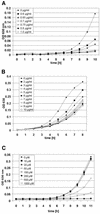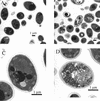Ciclopirox olamine treatment affects the expression pattern of Candida albicans genes encoding virulence factors, iron metabolism proteins, and drug resistance factors
- PMID: 12760852
- PMCID: PMC155814
- DOI: 10.1128/AAC.47.6.1805-1817.2003
Ciclopirox olamine treatment affects the expression pattern of Candida albicans genes encoding virulence factors, iron metabolism proteins, and drug resistance factors
Abstract
The hydroxypyridone ciclopirox olamine belongs to the antimycotic drugs used for the treatment of superficial mycoses. In contrast to the azoles and other antimycotic drugs, its specific mode of action is only poorly understood. To investigate the mode of action of ciclopirox olamine on fungal viability, pathogenicity, and drug resistance, we examined the expression patterns of 47 Candida albicans genes in cells grown in the presence of a subinhibitory concentration (0.6 micro g/ml) of ciclopirox olamine by reverse transcription-PCR. In addition, we used suppression-subtractive hybridization to further identify genes that are up-regulated in the presence of ciclopirox olamine. The expression of essential genes such as ACT1 was not significantly modified in cells exposed to ciclopirox olamine. Most putative and known virulence genes such as genes encoding secreted proteinases or lipases had no or only moderately reduced expression levels. In contrast, exposure of cells to ciclopirox olamine led to a distinct up- or down-regulation of genes encoding iron permeases or transporters (FTR1, FTR2, FTH1), a copper permease (CCC2), an iron reductase (CFL1), and a siderophore transporter (SIT1); these effects resembled those found under iron-limited conditions. Addition of FeCl(3) to ciclopirox olamine-treated cells reversed the effect of the drug. Addition of the iron chelator bipyridine to the growth medium induced similar patterns of expression of distinct iron-regulated genes (FTR1, FTR2). While serum-induced yeast-to-hyphal phase transition of C. albicans was not affected in ciclopirox olamine-treated cells in the presence of subinhibitory conditions, a dramatic increase in sensitivity to oxidative stress was noted, which may indicate the reduced activities of iron-containing gene products responsible for detoxification. Although the Candida drug resistance genes CDR1 and CDR2 were up-regulated, no change in resistance or increased tolerance could be observed even after an incubation period of 6 months. This was in contrast to control experiments with fluconazole, in which the MICs for cells incubated with this drug had noticeably increased after 2 months. These data support the view that the antifungal activity of ciclopirox olamine may at least be partially caused by iron limitation. Furthermore, neither the expression of certain multiple-drug resistance genes nor other resistance mechanisms caused C. albicans resistance to this drug even after long-term exposure.
Figures





Similar articles
-
Genome-wide expression profiling of the response to ciclopirox olamine in Candida albicans.J Antimicrob Chemother. 2005 May;55(5):655-62. doi: 10.1093/jac/dki105. Epub 2005 Apr 6. J Antimicrob Chemother. 2005. PMID: 15814599
-
Oxygen accessibility and iron levels are critical factors for the antifungal action of ciclopirox against Candida albicans.J Antimicrob Chemother. 2005 May;55(5):663-73. doi: 10.1093/jac/dki089. Epub 2005 Mar 24. J Antimicrob Chemother. 2005. PMID: 15790671
-
Antifungal effect of Echinophora platyloba on expression of CDR1 and CDR2 genes in fluconazole-resistant Candida albicans.Br J Biomed Sci. 2016;73(1):44-8. doi: 10.1080/09674845.2016.1155269. Br J Biomed Sci. 2016. PMID: 27182677
-
Ciclopirox: recent nonclinical and clinical data relevant to its use as a topical antimycotic agent.Drugs. 2010 Nov 12;70(16):2133-52. doi: 10.2165/11538110-000000000-00000. Drugs. 2010. PMID: 20964457 Review.
-
The two-component signal transduction system and its regulation in Candida albicans.Virulence. 2021 Dec;12(1):1884-1899. doi: 10.1080/21505594.2021.1949883. Virulence. 2021. PMID: 34233595 Free PMC article. Review.
Cited by
-
Effect of Dermaseptin S4 on C. albicans Growth and EAP1 and HWP1 Gene Expression.Probiotics Antimicrob Proteins. 2021 Feb;13(1):287-298. doi: 10.1007/s12602-020-09685-0. Probiotics Antimicrob Proteins. 2021. PMID: 32691243
-
Ciclopirox drives growth arrest and autophagic cell death through STAT3 in gastric cancer cells.Cell Death Dis. 2022 Nov 28;13(11):1007. doi: 10.1038/s41419-022-05456-7. Cell Death Dis. 2022. PMID: 36443287 Free PMC article.
-
Cation Transporters of Candida albicans-New Targets to Fight Candidiasis?Biomolecules. 2021 Apr 16;11(4):584. doi: 10.3390/biom11040584. Biomolecules. 2021. PMID: 33923411 Free PMC article. Review.
-
Ciclopirox olamine inhibits mTORC1 signaling by activation of AMPK.Biochem Pharmacol. 2016 Sep 15;116:39-50. doi: 10.1016/j.bcp.2016.07.005. Epub 2016 Jul 7. Biochem Pharmacol. 2016. PMID: 27396756 Free PMC article.
-
Superior efficacy of the antifungal agent ciclopirox olamine over gemcitabine in pancreatic cancer models.Oncotarget. 2017 Dec 8;9(12):10360-10374. doi: 10.18632/oncotarget.23164. eCollection 2018 Feb 13. Oncotarget. 2017. PMID: 29535812 Free PMC article.
References
-
- Abrams, B. B., H. Hänel, and T. Hoehler. 1992. Ciclopirox olamine: a hydroxypyridone antifungal agent. Clin. Dermatol. 9:471-477. - PubMed
-
- Bennett, D. E., C. E. McCreary, and D. C. Coleman. 1998. Genetic characterization of a phospholipase C gene from Candida albicans: presence of homologous sequences in Candida species other than Candida albicans. Microbiology 144:55-72. - PubMed
Publication types
MeSH terms
Substances
LinkOut - more resources
Full Text Sources
Medical
Molecular Biology Databases
Miscellaneous

